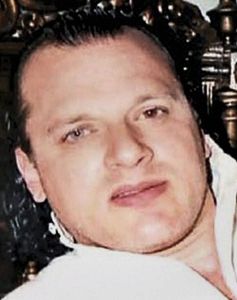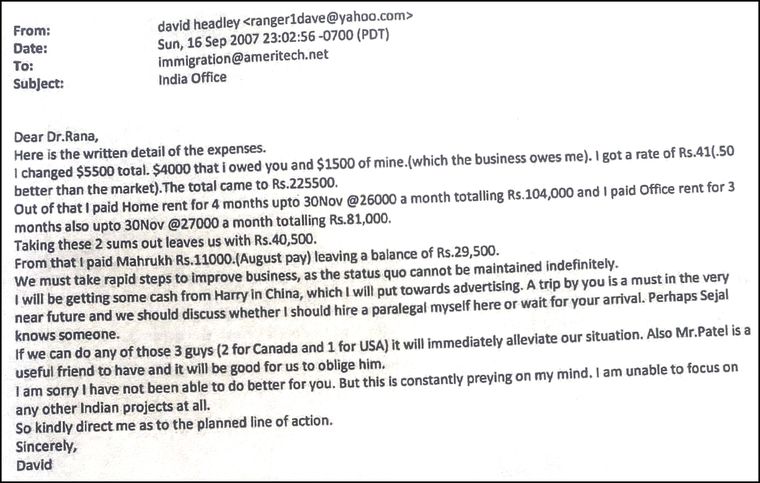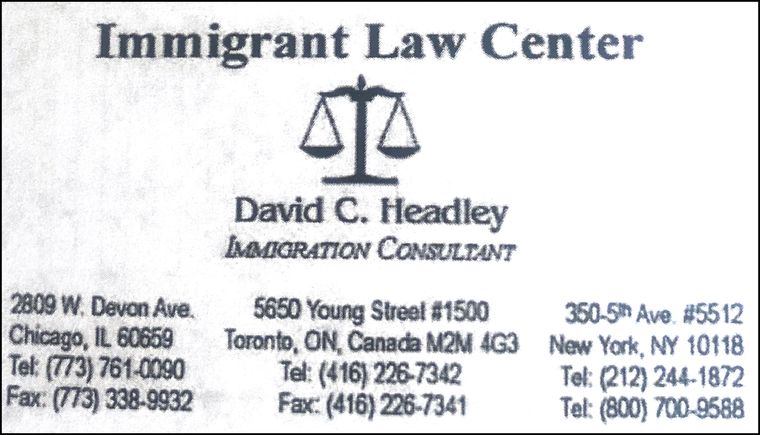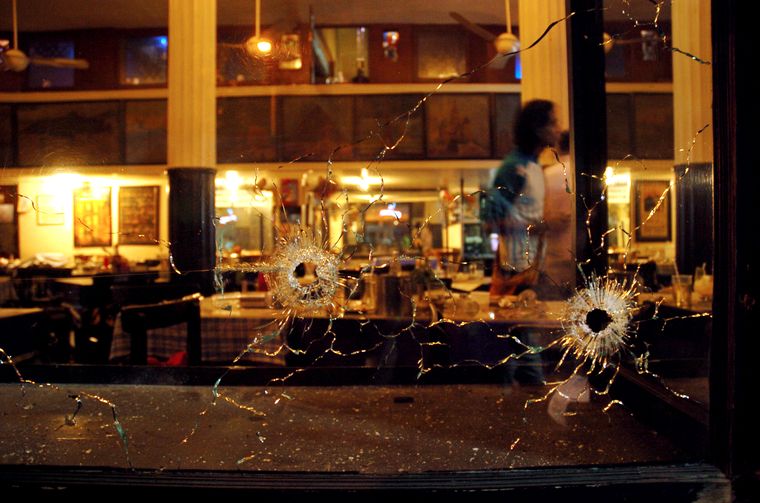When Tahawwur Hussain Rana immigrated to Canada from Pakistan in 1997, he was looking for a better future. The doctor found one, building a comfortable life, getting Canadian citizenship in 2001, and later moving to the US, where he established several businesses. One of these was First World Immigration Services in Chicago, through which he helped starry-eyed youngsters get US and Canadian visas quickly.
He rooted himself in community work by providing halal meat to Muslim customers at his farm in Kinsman, Illinois, and he would exchange daily pleasantries with customers at his grocery shop in Chicago. By all appearances, he was a successful professional―a model immigrant.
In fact, his youngest brother, Fakhar Abbas Rana, described him as a “compulsive entrepreneur” to sleuths of the Federal Bureau of Investigation. His eldest daughter said he was a businessman who did not make money for himself, rather provided opportunity and employment to people, sometimes even at his own expense.
The FBI wasn’t convinced. Beneath this respectable facade, Rana, father of three, was a man drawn into the world of extremist violence―one who lived a life of deception. He gave employment to terrorists, cover to Lashkar-e-Taiba operative David Coleman Headley to plot the 26/11 attacks in Mumbai, and celebrated the loss of several innocent lives in cahoots with Pakistani terror commander Major Iqbal, Al Qaeda operative Ilyas Kashmiri and LeT’s ‘India project’ head Sajid Mir, among others. In a recorded conversation with the FBI, Rana was heard laughing when he discussed five separate targets for attacks, directing praise towards the attackers. “Defendant expressed belief that the Mumbai attackers deserved one of Pakistan’s highest medals,” said the US government’s position paper seeking a 30-year sentence for Rana.
But even in his worst moments, the doctor managed to stay in the shadows. Following Headley’s arrest in the US on October 3, 2009, and then Rana’s on October 18, the spotlight was mostly on the former. Seen as someone on the ground in Mumbai―doing the recce and coordinating with LeT and Pakistan’s ISI―Headley’s perceived role took attention away from the linchpin, Rana.
As per a senior security officer, a close reading of the documents filed by US prosecutors reveals a different picture. For Rana, 26/11 was just the beginning and he was impatient with the pace at which Pakistan-based groups, including the ISI, were moving to execute further attacks. In a recording of a conversation on September 20, 2009, filed as evidence by the FBI, Rana was categorical to Headley that “business must go on”.
The cold-blooded personality of Rana and his overwhelming influence over Headley were brought out in a communication―which the FBI intercepted―on December 25, 2008, a month after the Mumbai attacks. Abdur Rehman Hashim Syed alias Pasha, a retired Pakistan army major close to Headley, asks about Rana: “How is the doctor’s (Rana) reaction on what is happening, is he terrified or relaxed?” Headley responds with, “Doctor is very relaxed.”
Rana was a mentor to Headley. Ideologically motivated and clinical in executing his plans, Rana conveyed a sense of “moral” purpose to his accomplices on the need for violence and mass murders.
No surprise then that President Donald Trump, briefed by senior FBI and Department of Justice officials, described Rana as “a very violent man” during his recent press conference with Prime Minister Narendra Modi.

“As President Trump has said, the US and India are working together to confront the threat of radical Islamic terrorism,” Christopher Elms, the US embassy spokesperson, told THE WEEK. “The administration has approved the extradition of Tahawwur Rana, one of the perpetrators of the horrific 2008 Mumbai terror attacks (currently in a Los Angeles prison) to face justice in India.”
Elms said that, during their recent meeting, Trump and Modi expressed their commitment to strengthening cooperation against threats from groups such as Al Qaeda, ISIS, Jaish-e-Mohammad and LeT. “Both countries will continue to fight the global scourge of terrorism,” he said, “and eliminate terrorist safe havens from every corner of the world.”
For Trump to call Rana “violent” is nothing short of an indictment of the man whom Delhi wants in order to uncover the post 26/11 conspiracy―Delhi being one of the prime targets.

And soon, the black cat commandos of the National Security Guard, who battled terrorists in 2008, will have another task at hand―bring Rana back in handcuffs in a special aircraft to Delhi, where he will be lodged in jail.
Rana is likely to be investigated on three counts: identifying key conspirators from ISI, LeT and Al Qaeda; financial trail of Headley’s activities in India; and terror conspiracies post 26/11.
“It has been a long process,” said former Indian ambassador to the US Arun K. Singh. “The extradition process of Rana began in 2010 and successive US governments have been helpful. The legal processes were underway and it was cleared by the US Supreme Court this January.”
The centrality of Rana in planning attacks and motivating Headley comes through in many instances. After 26/11, Headley informed Pasha that before going to Copenhagen for the ‘Mickey Mouse project’―code for the planned attack on a Danish newspaper for publishing cartoons of Prophet Muhammad―he needed to consult Rana. Similarly, intercepted communication between Headley and Mir showed that the handlers were aware of Rana’s influence over Headley. Mir said Headley was risking exposure by working on the ‘Mickey Mouse Project’ with Pasha and Kashmiri, and asked Headley to convey his greetings to Rana, knowing full well he was sponsoring Headley’s recce of the newspaper premises.
Rana was also in touch with Pasha, but failing to connect to Kashmiri through Pasha to arrange cadres for the Denmark attack, Rana went along with Iqbal and Mir’s plan to focus on targets in India.
In the first two years following 26/11, Indian authorities had no evidence on Rana. Former home secretary G.K. Pillai said it was only when the role of Headley came to light that Indian agencies found out about Rana’s limited involvement in providing cover for Headley during his recces.
What made it tougher was the plea bargain Headley entered into with the US Department of Justice in March 2010, which denied India his extradition. However, mounting pressure on the US paved the way for Indian investigators to question Headley. “This is the first instance when Headley confessed to Rana’s role as a key conspirator and we got insight into their roles,” said Loknath Behera, who interrogated Headley in Chicago in 2010.
Indian investigators moved swiftly. In 2014-15, Atulchandra Kulkarni, then joint commissioner of Mumbai Police, and Ujjwal Nikam, special public prosecutor in the 26/11 case, quietly flew to the US to meet senior FBI and state department officials to secure the cooperation of Headley, who was in US custody. This meeting led to his deposition before a special Mumbai court in 2016 through video, where he spilled the beans on his close association with Rana and the assistance Rana gave him when he was scouting for new targets.
However, India got no further access to either Headley or Rana, which opened up the possibility of several leads drying up. Rana, in the meantime, was busy exhausting legal options in the US.
According to a senior security official aware of US court proceedings, Rana did not need any push by the terror groups to plan and execute attacks. “Instead, Rana was urging the main players based in Pakistan to carry out more attacks without delay,” said the official.
Headley’s western background (he is Pakistani-American) made him the perfect infiltrator; he could move through global airports and major cities unnoticed. But, he needed a cover story, and Rana gave him one. He helped Headley set up a branch of his immigration business in Mumbai as a front.
Rana was discreet and operated through Headley. His meticulous cover was instrumental in the successful execution of 26/11, and could have led to more spectacular attacks in India, especially on the National Defence College in Delhi. Indian investigators had overlooked Rana to focus on Headley, but the former’s extradition could establish the missing links. The significance of Rana’s extradition is not simply legal or administrative, but more so in its scope to provide valuable intelligence for post-26/11 investigations.
Rana was an expert at covering his tracks. He used code to talk to key conspirators; attacks on targets were referred to as “investments”, “projects” and “business”. One instance quoted by the FBI reveals that when Rana was sending out a new email address―mov.monie@yahoo.com―created for Headley’s use, his email read: “One of my brothers is Brigadier Movadat Hussain Rana and the other is Sibte Hassan Rana monie. They are in Rawalpindi. I really admire emails making it instant half mulaquat, especially yahoo as it seems superior to hotmail. Talk to you later.”
The wiretaps, emails and financial records gathered by the FBI can be damning evidence of the extent of Rana’s involvement, not just as a sympathiser or associate, but also as a facilitator who provided logistical support and cover for international terror plots.
Born in 1961 in Chichawatni, Pakistan, Rana pursued a career in medicine, which landed him the job of a doctor in the Pakistan army medical corps, where he gained experience and discipline. But by the late 1990s, he sought a new life. And this new life began with camouflage.
When Rana entered North America, he kept two fronts to conceal his violent personality. The first was his membership in the Iqbal society, a group named after philosopher-poet Muhammad Iqbal, to suggest his beliefs were aligned with peaceful intellectualism. Second, he invoked Mahatma Gandhi’s principles of non-violence. After the FBI arrested him in 2009, he brought up these defences in US courts, along with character witnesses. But the FBI dismissed it.
“These individuals had limited interactions, nothing more than exchange of greetings with Rana, and another whose business dealings consist of buying meat from Rana’s butchery,” noted a US government memorandum.
What is more interesting is how Rana’s team spun his relationship with Headley. “Headley and Rana’s friendship is over. The two will never communicate or see each other again, either in prison or outside,” Rana’s counsel Patrick W. Blegen and his team told US courts in 2013. “Quite simply, had Headley and Rana never attended the same boyhood school, Rana would not be before this court today.”
In his defence, Rana told the court that Headley tried to convert him over the years, but he resisted the pressure. Rana’s consultant, Dr Marc Sageman, even submitted a letter explaining how Rana never supported terrorism directly. “His involvement was always in relation to Headley,” he said.
Rana said it was out of his sense of loyalty that he helped Headley when needed, like conquering a serious drug addiction and going so far as putting his house up as collateral for Headley to obtain a bond so he could cooperate with the Drug Enforcement Administration and get a reduced sentence. “This continued friendship and loyalty to Headley ultimately led to Rana’s downfall,” said his counsel.
However, a senior security official who tracked the extradition proceedings claimed that Rana’s defence of inherent personality differences with Headley was only to get away with minimum sentences. The official said the US government quoted Rana’s wife to refute this defence. The FBI recorded her as saying, “Both Rana and Headley are alike and have ended up together.... They talk nonsense all day... such as ‘kill him, he is not practising like us―kill him…’”
US-born Headley, 65, went to a military cadet college in Hasan Abdal in Attock district of Pakistan’s Punjab. This is where he met Rana. The duo did not realise they will cross paths again till Headley joined the LeT in 2001. Little is known so far about Rana’s “indoctrination and training” before he met Headley, who had completed training in Muzaffarabad and had met LeT patron Hafiz Saeed.
Headley said he met Rana for the first time, after school, when he landed at Rana’s Chicago home in June 2006 looking for an Indian visa. They were in touch on phone before that, but there is no clarity as to exactly when they first began talking. Headley stayed in Chicago for a few weeks and discussed the opening of the Immigrant Law Centre―a branch of Rana’s business―in Mumbai. He shared LeT and ISI plans with Rana, who not only agreed to help, but also took him under his wing, prepared his documents and got him the Indian visa within days. “Dr Rana influenced my thoughts and actions,” Headley confessed in US court. “I could understand he had genuine feelings to fight for the cause.”
Towards the end of Headley’s training in Pakistan, he would often bring up “Dr Rana” with the ISI’s Major Iqbal. According to Headley, Rana had deserted the Pakistan army in the early 1990s and had never returned. Major Iqbal assured Headley that he would help Rana visit Pakistan, and Headley passed on Rana’s contact to him. The major, who oversaw the planning and execution of 26/11, kept his promise and helped Rana reach Pakistan. “It was decided that we would talk in English whenever I called up Dr Rana from India,” said Headley, who changed his name from Daood Gilani―an identity he had used to travel to countries like the UK, France, Germany, Maldives and Sri Lanka―to begin his recce of targets in India.
What has become clear to investigators in India and the US is that Rana held the key to Headley’s stay in India, and Pakistan knew this. “The US must have felt pressure to cooperate in Rana’s extradition after Headley’s plea bargain,” said a senior diplomat. “They could not afford to miss this chance of close counter-terror cooperation with India.”
Developments in US courts indicate that Rana was not only Headley’s mentor, but also his window to Pakistan for future action. Interestingly, the LeT did not give any money directly to Headley for the first few trips to India. Instead, Rana handled his visit by connecting him with one Bashir, who would receive him at Mumbai airport. At this juncture, Headley stopped using his Pakistan number and started communicating with the Pakistani handlers through Rana. For Delhi, this is a key marker of Rana’s role in terror conspiracies hatched on Indian soil; he was the brain behind Headley.
“Rana’s interrogation can give more information on elements in Pakistan who were either with the ISI or other agencies and were communicating with him,” said M.A. Ganapathy, former director general of the National Security Guard. The fact that Rana knew of Headley’s recce of targets like the National Defence College and the Bhabha Atomic Research Centre can give more insights into the larger terror conspiracy to the National Investigation Agency. Ajmal Kasab was, after all, a foot soldier and did not know either Headley or Rana. “But since Rana was giving cover to Headley in India, he can also shed light on the foot soldiers who were part of the 26/11 conspiracy,” added Ganapathy.
Between September 2006 and November 2008, Headley made eight trips to Pakistan and seven trips to India. He was travelling between the US, India and Pakistan during this time. At each stage, he informed Rana about surveillance of important targets in India. During his visits to Pakistan, he briefed officials of the Pakistani army and LeT’s Mir and Zakiur Rehman Lakhvi, and shared memory sticks of locations in Mumbai. Lakhvi listened intently to his activities over long meetings, and offered him milk and saffron after the first few visits. Headley had watched videos of a large number of sadhus taking a holy dip and presumed the place could be Varanasi or the Kumbh mela, before he was told that Mumbai was the target. Rana remained in close contact providing mental support to Headley. The two even shared personal secrets. In February 2007, when Headley secretly married Moroccan national Faiza Outalha, a student at a medical college in Lahore, he confided in Rana. He once left Mumbai and went to Lahore for five days to attend to personal issues without informing his handlers. “Of course I had discussed these issues with Dr Rana,” said Headley.
In the lead-up to 26/11, Headley was flooded with suggestions from across the border―Pasha wanted recce of NDC in Delhi, Major Iqbal wanted recce of Pune and Headley visited Jaipur himself. There were photographs of the Brihanmumbai Municipal Corporation building, Haji Ali, Gateway of India, Apollo Bunder, Maharashtra state police headquarters, Azad Maidan, areas close to Hotel Outram and Marine Drive.
Other suggested targets included Taj President, Bollywood, Shiv Sena, the World Trade Centre, the naval air station, Siddhivinayak Temple, Chabad house, the Bombay Stock Exchange, the Radio Club, and the Somnath Temple in Gujarat.
By the end of 2007, Taj Hotel and NDC remained on top of the list. When Major Iqbal asked Headley to explore Bhabha Atomic Research Centre and its residential complex as a potential target, Headley mentioned this to Rana. The two then discussed the pros and cons of targetting a nuclear installation. “Dr Rana told me about a bilateral agreement between India and Pakistan about no use of force on each other’s nuclear installations,” Headley told the FBI and the NIA.
Investigators will now be keen to understand from Rana what happened once these recce videos reached Pakistan and whether Rana gave Headley any instructions for follow-up action. His questioning will also give more insights into the Pakistani handlers, who continue to operate away from the prying eyes of Indian and US agencies, even after the arrest of Headley and Rana.
After 26/11, Rana advised Headley to close the immigration office in Mumbai and explore opening an office in Delhi. The questions that remain are whether Rana had already done groundwork using a different set of foot soldiers for this plan of opening an office in Delhi. Why would he suggest opening a new one without preparation? Was Rana running the immigration office in Mumbai with the help of some contacts in Delhi and other cities as well? Will these unknown details pave the road for the NIA to track down more foot soldiers and discover more spots recced by the LeT for future action? Rana’s questioning can shed light on these loose ends.
As 26/11 drew closer, Rana and Headley became thicker. On September 8, Headley moved his family to the US; Rana’s family received them in Chicago. His relationship with Faiza had gone sour but Rana stuck by his side. From November 21-24, days before the attacks, Rana was in Dubai to meet Pasha. Did Pasha tell Rana about the attacks beforehand? When the Mumbai attacks unfolded, Rana was mid-flight, travelling back to the US; investigators believe he already knew what was happening.
Also Read
- Who is the key contact Tahawwur Rana met in Dubai ahead of 26/11 Mumbai attacks? NIA probes
- Tahawwur Rana told Headley Indians ‘deserved 26/11 Mumbai attacks’: US justice dept
- ‘Tahawwur Rana visited Kochi too’: Former NIA cop who interrogated 26/11 Mumbai attacks mastermind David Coleman Headley reveals
- 'Tahawwur Rana helped David Headley get 10-year visa, contacted Pak Major Iqbal before 26/11 Mumbai attack'
- Who is Narender Mann, the special prosecutor handling 26/11 terror attack conspirator Tahawwur Rana's case?
- Tihar jail all set to ‘welcome’ to Tahawwur Rana, special flight to reach today
During a long car ride on September 7, 2009, Rana and Headley spoke freely about their involvement in past and future terror plots, revealing the depth of their trust and shared mission. The US government memorandum supporting Rana’s detention details how the two men, unaware that authorities were listening, discussed the 2008 Mumbai attacks and praised the masterminds behind them. “They should be really commended. I appreciate them from my heart,” said Rana. He even conferred upon Mir the name “Khalid ibn Walid,” a famous Muslim general, for the “very successful” Lashkar operations. At one point in the conversation, Headley pressed Rana on how he learned about the attacks while in transit. Rana admitted that he had been informed beforehand. The US government presented this as damning evidence that Rana had prior knowledge of the massacre, contradicting his later claims that he did not know about the attack and he was only handling Headley’s stay in Mumbai.
Headley has testified that Rana was fully aware of both the Mumbai and Danish plots. Rana’s defence seems too little too late as Indian authorities are clearing the paperwork to bring him to Delhi. The next steps will be to confront Rana with his own disclosures, and running through long wiretaps related to another strike on India, including the NDC, which he referred to as a “good target” after 26/11.







